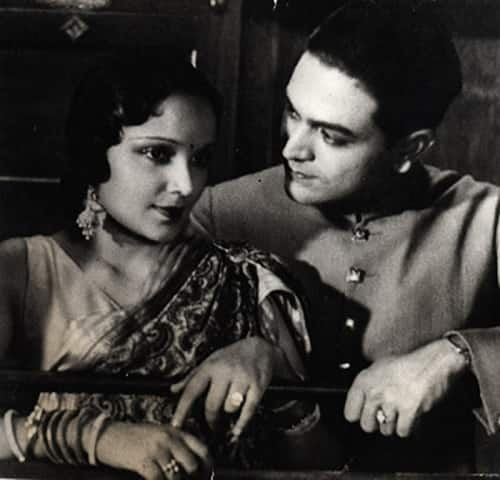



The era of pioneering film studios which heralded the birth of indigenous film-making in India has been ably captured by the Amazon series Jubilee. Loosely based on the Malad-based Bombay Talkies, established by the pioneering couple Himansu Rai and Devika Rani in the mid-1930s, it offers a window to a period when stars, writers, and technicians were paid monthly salaries by film studios.
As the series begins just months before India’s Independence, it rightly weaves its narrative in the backdrop of Partition violence, refugee rehabilitation, Cold War, and the AIR placing restrictions on Hindi film songs. In real life, however, Bombay Talkies arguably had its most productive run during the British rule although Rai’s untimely death in 1940 was a big jolt. Rani continued helming the studio, but changed circumstances, and her own marriage in 1945 to artist Svetoslav Roerich, eventually brought down the curtains on Bombay Talkies in 1953.
 Devika Rani and Najmul Hasan in Jawani Ki Hawa (1935). (Image via Wikimedia Commons)
Devika Rani and Najmul Hasan in Jawani Ki Hawa (1935). (Image via Wikimedia Commons)A glimpse of Rai’s entrepreneurial spirit and confidence comes alive in his quest for the sole rights to film the Silver Jubilee celebrations of the British monarch King George V in India in May 1935. Rai endeavoured to get exclusive rights to film the celebrations in the important cities of Simla and Delhi along with other parts of the country.
And the smart businessmen that he was, Rai sought free transport, boarding and lodging facilities for the team of technicians and workers who would be involved in the filming of the Jubilee Celebration, reminding in letters (from December 1934 onwards) to British officials that the cost of organizing, producing and distributing the film would be his responsibility.
Amazon’s Jubilee may have missed this attempt by Rai to film this once-in-a-lifetime opportunity in order to have exclusive footage of the British monarch’s Jubilee celebrations, but archival records provide evidence of the huge push Rai and his influential fellow directors at Bombay Talkies made to obtain this lucrative deal.
Sir Chimanlal Setalvad, an eminent barrister and noted public personality, was the chairman of Bombay Talkies, which also had renowned financier F.E. Dinshaw and other industry captains like Chunilal Mehta, Sir Cowasji Jehangir, and Sir Richard Temple, whose father was a former Governor of Bombay and Bengal, as directors. The Nizam of Hyderabad and the Maharaja of Jaipur also had shares in Bombay Talkies, adding further heft in the attempt to secure the exclusive filming rights.
But Bombay Talkies was not alone in the race. There was another major player interested in capturing the Jubilee celebrations - the Gaumont British News. Perhaps getting a whiff of the stiff competition, Rai highlighted in his correspondence: “Our cameras, sound recording equipment, lights, processing and editing appliances are of the same makes as are now in use in Gaumont-British and other well-known studios in London.” As an added incentive, Rai offered to provide free of cost some of the lights that might be needed by the administration for the celebrations.
Rai and Rani had met on foreign shores (England/Germany) where they were pursuing their passion for films. Professor Rosie Thomas, an expert on Indian cinema, quotes Rai telling Rani, “Let us learn from these people, but let us put the knowledge to work in our country.” The couple returned to India in the mid-1920s with the aim to produce films that would match in quality the best globally.
 A postcard shows a still from the 1925 silent film 'Prem Sanyas' ('The Light of Asia'), starring Seeta Devi (born Renee Smith) and Himanshu Rai. (Photo via Wikimedia Commons)
A postcard shows a still from the 1925 silent film 'Prem Sanyas' ('The Light of Asia'), starring Seeta Devi (born Renee Smith) and Himanshu Rai. (Photo via Wikimedia Commons)Before Bombay Talkies was established in 1934, the couple had made films like Shiraz, Light of Asia, A Throw of Dice which were shown in theatres worldwide. Their connections and exposure to European cinema meant that English, German and French technicians worked alongside Indians at Bombay Talkies in the distant suburb of Malad.
Rai’s attempt to get sole rights for the Jubilee Celebrations came to naught because the Viceroy Lord Willingdon’s office had already told Gaumont British News in September 1934 that their representatives would be given every facility to cover the Jubilee celebrations in India. This meant that sole rights could not be given to Rai, although the British did explore giving him the same for the filming of celebrations which were not open to the public.
Rai’s plan was to exchange Jubilee Films produced in various parts of the Empire and to ultimately edit all of them in one single Empire Film. It could have been a money spinner for Bombay Talkies, besides establishing a much-sought-after Royal connection, in the early months of the studio's existence.
Bombay Talkies missed out on George V’s Jubilee celebrations, but went on to nurse talents, and launch several memorable careers, a racy glimpse of which can be gleamed from the Jubilee series.
Also read: Evolution of the kiss on the Indian silver screen
Discover the latest Business News, Sensex, and Nifty updates. Obtain Personal Finance insights, tax queries, and expert opinions on Moneycontrol or download the Moneycontrol App to stay updated!
Find the best of Al News in one place, specially curated for you every weekend.
Stay on top of the latest tech trends and biggest startup news.